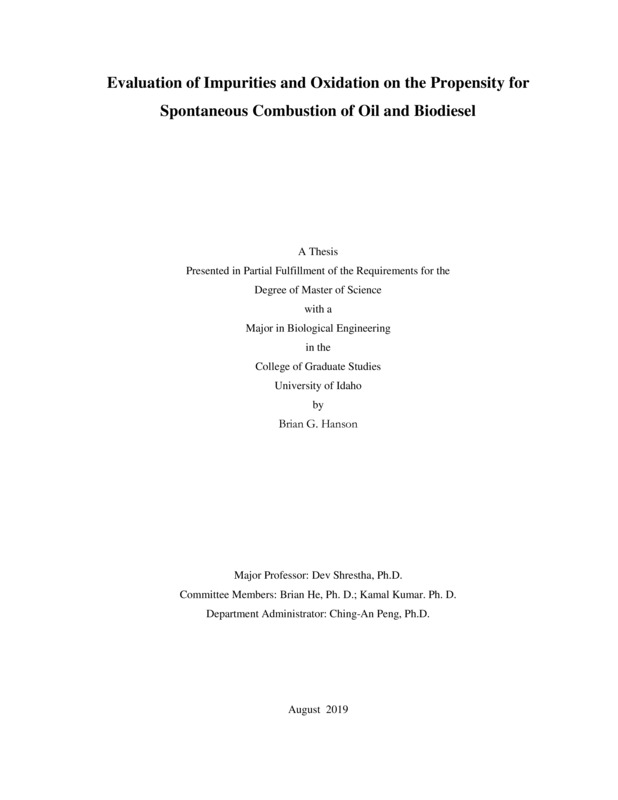Evaluation of Impurities and Oxidation on the Propensity for Spontaneous Combustion of Oil and Biodiesel
Hanson, Brian Gordon. (2019-08). Evaluation of Impurities and Oxidation on the Propensity for Spontaneous Combustion of Oil and Biodiesel. Theses and Dissertations Collection, University of Idaho Library Digital Collections. https://www.lib.uidaho.edu/digital/etd/items/hanson_idaho_0089n_11612.html
- Title:
- Evaluation of Impurities and Oxidation on the Propensity for Spontaneous Combustion of Oil and Biodiesel
- Author:
- Hanson, Brian Gordon
- ORCID:
- 0000-0001-5197-0427
- Date:
- 2019-08
- Keywords:
- biodiesel fire linseed oil spontaneous combustion waste vegetable oil
- Program:
- Biological & Agricultural Engineering
- Subject Category:
- Bioengineering; Transportation; Energy
- Abstract:
-
Climate change and the increasing demand for renewable energy has created a new world that is frantically looking for innovative answers to solve both. Biofuels, energy sources built from solar energy and atmospheric carbon, is regaining popularity as a potential solution. An advanced biofuel called biodiesel shows promise through its energy density, cleaner emissions, and ability to run in diesel engines without any engine modification. Biodiesel is unique because it can be made from any plant or animal oil. Since a large variety of these oils can be used to produce high-quality fuels, each biofuel has its own set of distinct properties. While all these oils can be used to create biodiesel, unsaturated oils undergo autoxidation faster than saturated oils. Autoxidation causes the plant oils to become rancid, giving the oil a foul taste and undesirable properties to the fuel. In addition, the fuel loses energy density and becomes susceptible to forming polymers which can plug fuel filters. When highly unsaturated oils are thermally insulated while drying, spontaneous combustion may occur. Spontaneous combustion is considered the result of autoxidation, an exothermic curing reaction.
Several biodiesel production facilities have recently burnt down, costing millions in damages without a known cause, with some events being attributed to spontaneous combustion. Considering the production of biofuels is increasing and many locations are hitting record high temperatures, it is significant to understand how both biofuels and plant oils spontaneously combust to safeguard future investments and establish safer operations. Using off-the-shelf components and minimal custom fabrication, a safe testing device was developed. The device provides a safe and repeatable testing method for investigating spontaneous combustion phenomena.
Using this device, a Spontaneous Combustion Severity Index (SCSI) was developed based on heat generation pattern inside the reactor in a short-term experiment. The SCSI number provided a way to quantify the likelihood of spontaneous combustion. An experiment for spontaneous combustion was designed from a combination of oils, biodiesels, and chemicals commonly encountered in biodiesel industries. The test showed that both types of feedstock and impurities in biodiesel and oil played a significant role in the likelihood of spontaneous combustion.
- Description:
- masters, M.S., Biological & Agricultural Engineering -- University of Idaho - College of Graduate Studies, 2019-08
- Major Professor:
- Shrestha, Dev
- Committee:
- He, Brian; Kumar, Kamal
- Defense Date:
- 2019-08
- Identifier:
- Hanson_idaho_0089N_11612
- Type:
- Text
- Format Original:
- Format:
- application/pdf
- Rights:
- In Copyright - Educational Use Permitted. For more information, please contact University of Idaho Library Special Collections and Archives Department at libspec@uidaho.edu.
- Standardized Rights:
- http://rightsstatements.org/vocab/InC-EDU/1.0/

